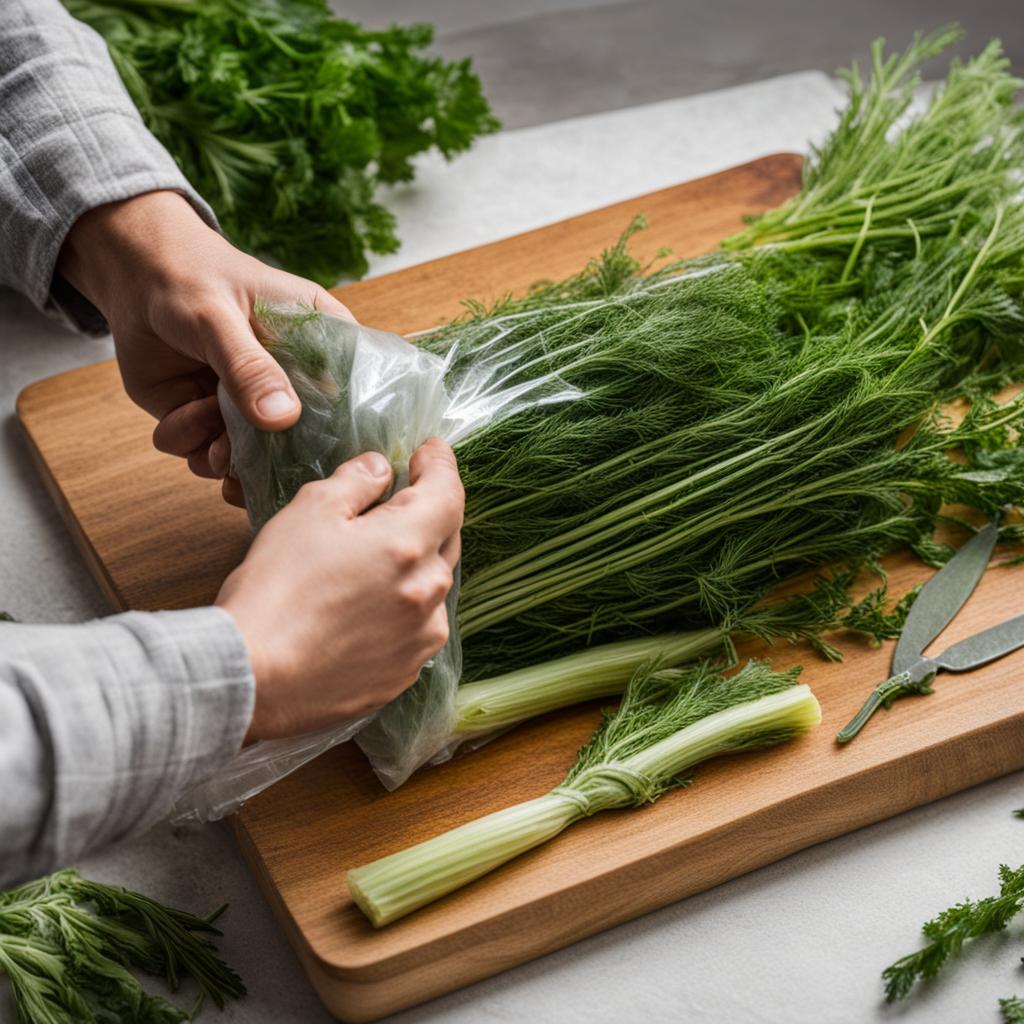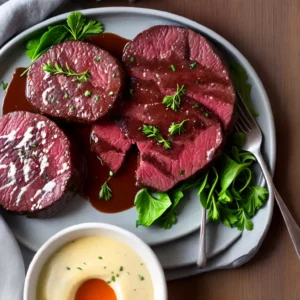In this guide, I will show you how to freeze fennel to preserve its flavor and texture. Fennel is a versatile vegetable with multiple uses, and proper preparation and storage are essential to maintain its freshness. Whether you want to freeze the stalks, fronds, or bulbs, or learn about other fennel preservation methods, this article will provide you with all the information you need.
Key Takeaways:
- Learn how to freeze fennel to extend its shelf life and enjoy its taste throughout the year.
- Discover different fennel preservation methods, including freezing, pickling, and storing the bulbs, stalks, and fronds separately.
- Find out how to properly store and use frozen fennel in various recipes, from soups to stir-fries.
- Explore additional tips for storing and preserving herbs to enhance your culinary creations.
- Experiment with frozen fennel and other herbs to add unique flavors and textures to your dishes.
What is Fennel? Plus How to Prep & Cook It
Fennel is a versatile vegetable that adds a unique flavor to various dishes. It has a fragrant and flavorful profile, reminiscent of a mix of licorice and anise. Fennel consists of a bulbous base with stalks and feathery fronds. All parts of the fennel plant are edible and have different culinary uses.
Before preparing and cooking fennel, it’s essential to select firm bulbs that are free from blemishes. To prepare fennel for cooking, start by removing the stalks and fronds. The stalks can be stored separately for future use, while the fronds can be used as a garnish or added to salads. Once the stalks and fronds are removed, slice the fennel bulb as desired for your recipe.
To cook fennel, there are various methods you can try. Fennel can be roasted, sautéed, braised, or added to soups and stews. Cooking fennel enhances its natural sweetness and softens its texture. Whether you’re looking to incorporate fennel into a main dish, side dish, or salad, experimenting with different cooking techniques can help you discover your favorite way to enjoy this flavorful vegetable.
Fennel Preparation Tips
- Select firm fennel bulbs without blemishes for the best flavor.
- Remove the stalks and fronds before cooking.
- Store the stalks separately for future use.
- Slice the fennel bulb as desired for your recipe.
“Fennel adds a unique and refreshing flavor to dishes and can be a versatile ingredient in your cooking repertoire.” – Professional Chef
Culinary Uses of Fennel
Fennel can be used in a variety of culinary applications. Its unique flavor pairs well with seafood, chicken, pork, and various vegetables. Here are a few common culinary uses of fennel:
- Adding sliced fennel to salads for a fresh and crunchy texture.
- Roasting fennel with olive oil, salt, and pepper for a flavorful side dish.
- Sautéing fennel with onions and garlic as a base for pasta sauces or risottos.
- Braising fennel in broth or wine for a tender and flavorful result.
- Using fennel fronds as a garnish for soups, stews, or roasted dishes.
With its distinct flavor and versatility, fennel can elevate the taste of your dishes and add an interesting twist to your culinary creations.
| Culinary Use | Description |
|---|---|
| Sliced Fennel in Salads | Adding sliced fennel to salads for a fresh and crunchy texture. |
| Roasted Fennel | Roasting fennel with olive oil, salt, and pepper for a flavorful side dish. |
| Sautéed Fennel | Sautéing fennel with onions and garlic as a base for pasta sauces or risottos. |
| Braised Fennel | Braising fennel in broth or wine for a tender and flavorful result. |
| Fennel Frond Garnish | Using fennel fronds as a garnish for soups, stews, or roasted dishes. |
How to Store Fennel in the Refrigerator
Properly storing fennel in the refrigerator is essential to keep it fresh and flavorful for longer. Here are some tips on how to store fennel:
1. Wrap it up:
When storing fennel in the refrigerator, it’s best to wrap it in a kitchen towel or paper towels. This helps absorb excess moisture and prevents the fennel from becoming soggy. Alternatively, you can place the fennel in a plastic bag, making sure to leave the bag slightly open to allow for some airflow.
2. Remove the stalks and fronds:
If the fennel bulb comes with stalks and fronds, it’s recommended to remove them before storing. The stalks and fronds can be stored separately and used as an herb in other dishes. By removing them, you can prevent moisture loss and keep the fennel bulb fresh.
3. Choose the right spot:
When storing fennel in the refrigerator, it’s important to place it in the warmer sections, such as the top shelf or a drawer. This helps maintain its texture and flavor. Avoid storing fennel near foods with strong odors, as it can absorb those flavors.
4. Don’t wash until ready to use:
It’s important not to wash fennel until you’re ready to use it. Moisture promotes mold growth, so keeping the fennel dry until needed helps prolong its shelf life. Wash and prepare the fennel just before cooking to ensure maximum freshness.
By following these storage tips, you can keep your fennel fresh in the refrigerator for up to 10 days, ready to be used in your favorite recipes.
Freezing Fennel: Tips and Instructions
Freezing fennel is a convenient way to preserve this versatile vegetable for future use. While the stalks and fronds can be frozen as is, the bulb requires some preparation to maintain its texture and flavor. Here are some tips and instructions to help you freeze fennel effectively:
- Start by trimming and discarding any bruised or damaged parts of the fennel bulb. Rinse it thoroughly under cold water to remove any dirt or debris.
- Cut the fennel bulb into slices or chunks, depending on how you plan to use it. Keep in mind that thicker slices may require longer cooking times.
- Blanch the fennel bulb by briefly immersing it in boiling water for about 2 minutes. This process helps to preserve its color, texture, and flavor.
- After blanching, transfer the fennel bulb to a bowl of ice water to cool it down rapidly and stop the cooking process. Leave it in the ice water for the same amount of time as blanching.
- Once cooled, pat the blanched fennel bulb dry using a clean kitchen towel or paper towels. Excess moisture can lead to freezer burn, so it’s important to remove as much moisture as possible.
- Place the blanched and dried fennel bulb into airtight freezer bags or containers. Label the bags with the date and use them within 3 to 6 months for the best quality.
- Store the frozen fennel in the freezer at 0 degrees Fahrenheit or below. Avoid placing it near the freezer door to minimize temperature fluctuations.
By following these instructions, you can ensure that your frozen fennel retains its taste and texture when you’re ready to use it.
Comparison Table: Freezing Fennel Methods
| Method | Advantages | Disadvantages |
|---|---|---|
| Freezing Stalks and Fronds | – Simple and quick – Preserves flavor and aroma – Versatile for use in various dishes |
– Limited to stalks and fronds only – Texture may change slightly |
| Blanching the Bulb | – Preserves color and texture – Maintains flavor – Longer storage life |
– Requires blanching process – Texture may change slightly |
| Pickling | – Adds tangy flavor – Prolongs storage life – Versatile for use in various dishes |
– Requires additional ingredients – Changes the taste profile |
As shown in the comparison table above, each freezing method has its own advantages and disadvantages. Consider your preference and intended use when choosing the best method for preserving your fennel.
Blanching Fennel for Freezing
Blanching is a crucial step in the process of freezing fennel. It helps to preserve the texture and flavor of the vegetable, ensuring that it remains fresh and ready to use even after being frozen. To blanch fennel, start by cutting the bulb into slices or chunks. Then, bring a pot of water to a boil and add the fennel pieces. Let them boil for about 30 seconds, and then quickly transfer them to a bowl of ice water to stop the cooking process. This blanching method helps to retain the vibrant green color of the fennel and maintains its crispness.
After blanching, drain the fennel thoroughly and steam-dry it to remove excess moisture. This step is important to prevent ice crystals from forming during freezing, which can negatively affect the texture of the fennel. Once dry, pack the blanched fennel into portion-sized freezer bags or containers, making sure to squeeze out as much air as possible to prevent freezer burn. Label the bags with the date and freeze them immediately. This blanched fennel can be stored in the freezer for up to six months.
Tips for Blanching Vegetables
Blanching is a versatile technique that can be applied to various vegetables for freezing. Here are a few tips to keep in mind:
- Choose fresh, high-quality vegetables for blanching. The better the quality of the produce, the better the results after freezing.
- Blanch vegetables in small batches to ensure even cooking and to prevent overcrowding in the pot.
- Have a large bowl of ice water ready to immediately cool down the blanched vegetables. This helps to halt the cooking process and preserve their color and texture.
- Blanching times may vary depending on the vegetable. It’s important to follow specific blanching instructions for each type to achieve the best results.
- After blanching, drain the vegetables well and remove any excess moisture before freezing. Excess moisture can lead to ice crystals and freezer burn.
By blanching fennel before freezing, you can ensure that you have a readily available supply of this versatile vegetable to incorporate into your favorite recipes throughout the year. Whether you use it in soups, stews, stir-fries, or other dishes, blanched frozen fennel will retain its taste, texture, and vibrant color, adding a burst of freshness to your culinary creations.
Pickling Fennel for Storage
Preserving fennel through pickling is a wonderful way to extend its shelf life and enhance its flavors. Pickled fennel adds a tangy and refreshing twist to various dishes and can be enjoyed throughout the year. Follow my simple steps below to pickle fennel and unlock a world of culinary possibilities.
To start, you’ll need fresh fennel bulbs. Clean and trim the bulbs, removing any tough outer layers. Slice the fennel into thin strips or wedges, depending on your preference. Next, place the fennel slices in a bowl and generously sprinkle them with salt. This step helps draw out excess moisture and maintains the crisp texture of the fennel.
Allow the salted fennel to sit overnight, allowing the flavors to meld and the salt to work its magic. In the morning, rinse the fennel slices thoroughly to remove the excess salt. Pat them dry with a clean kitchen towel or paper towels to remove any excess moisture.
Now it’s time to prepare the pickling solution. In a saucepan, combine equal parts vinegar and water. Add sugar, fresh dill, lemon zest, and any other desired flavorings to the mixture. Bring the solution to a boil, stirring until the sugar dissolves completely.
Place the rinsed and dried fennel slices in clean, sterilized jars. Pour the hot pickling solution over the fennel, ensuring that they are completely submerged. Seal the jars tightly and let them cool to room temperature. Once cooled, transfer the jars to the refrigerator for at least 24 hours to allow the flavors to develop fully.
When you’re ready to use your pickled fennel, simply remove the desired amount from the jar and enjoy. Pickled fennel makes a fantastic addition to salads, sandwiches, charcuterie boards, or even as a tangy condiment for grilled meats. The vibrant flavors and crisp texture of pickled fennel are sure to elevate your culinary creations.
Storing Fennel Bulbs, Stalks, and Fronds Separately
When it comes to storing fennel, you have the option of separating the bulbs, stalks, and fronds to ensure maximum freshness. Properly wrapping and packing each part will help maintain their individual flavors and textures.
Storing Fennel Bulbs:
To store fennel bulbs, start by trimming off any excess stalks and fronds. Once cleaned and trimmed, tightly wrap each bulb in plastic wrap or place them in an airtight container. This will prevent moisture loss and keep the bulbs fresh for up to 10 days in the refrigerator. Remember to label the container or wrap so you can easily identify them when needed.
Storing Fennel Stalks:
If you want to store fennel stalks separately, loosely wrap them in a damp paper towel before refrigerating. This will help retain their moisture and prevent them from drying out too quickly. You can place the wrapped stalks in a plastic bag to provide extra protection.
Storing Fennel Fronds:
Fennel fronds can be stored similar to other herbs. Begin by trimming off the fronds from the stalks. Then, wrap the fronds in a damp paper towel to maintain their freshness. Place the wrapped fronds in an open plastic bag and store them in the refrigerator. This method will help extend their shelf life for up to a week.
By storing fennel bulbs, stalks, and fronds separately, you can ensure that each part stays fresh and flavorful until you’re ready to use them. Whether you’re cooking up a delicious fennel-infused dish or need a garnish for your culinary creations, having properly stored fennel on hand will make all the difference in your cooking experience.
| Type of Fennel | Storage Method | Shelf Life |
|---|---|---|
| Bulbs | Tightly wrap in plastic wrap or store in an airtight container | Up to 10 days |
| Stalks | Loosely wrap in a damp paper towel, place in a plastic bag | Up to 1 week |
| Fronds | Wrap in a damp paper towel, place in an open plastic bag | Up to 1 week |
Using Frozen Fennel in Cooking
When it comes to cooking with frozen fennel, the possibilities are endless. Incorporating this versatile vegetable into your dishes is a breeze, and it adds a unique flavor and texture to any recipe. Whether you’re making soups, stews, stir-fries, or even pasta dishes, frozen fennel can be a game-changer in the kitchen.
To use frozen fennel, simply add it directly to your dishes without the need to thaw. The frozen fennel will cook perfectly alongside other ingredients, infusing your dishes with its distinct taste. The texture of frozen fennel may change slightly after freezing, but its flavor and aroma will remain intact.
Try adding frozen fennel to your favorite soup or stew to enhance the overall taste. The subtle hint of licorice and anise in fennel adds a depth of flavor that complements a variety of ingredients. You can also toss frozen fennel into stir-fries for a burst of freshness or incorporate it into pasta dishes for a unique twist.

Table: Quick and Easy Frozen Fennel Recipes
| Recipe | Description |
|---|---|
| Fennel and Tomato Soup | A comforting and flavorful soup that combines the sweetness of tomatoes with the subtle licorice taste of frozen fennel. |
| Fennel and Chicken Stir-Fry | A quick and healthy stir-fry that pairs tender chicken with crisp vegetables, including frozen fennel, for a burst of flavor. |
| Roasted Fennel and Pasta | A simple yet delicious pasta dish that combines roasted fennel with al dente pasta and a sprinkle of Parmesan cheese. |
These recipes are just a starting point. Feel free to experiment with different ingredients and cooking techniques to create your own frozen fennel masterpieces. With its unique taste and versatility, frozen fennel is sure to become a staple ingredient in your kitchen.
Storing and Using Frozen Fennel Stalks and Fronds
When it comes to freezing fennel, don’t forget about the stalks and fronds! These parts of the fennel plant can be just as flavorful and versatile as the bulb itself. Storing frozen fennel stalks and fronds is a great way to preserve their culinary potential for future use.
To store frozen fennel stalks and fronds, begin by removing any damaged or discolored portions. Then, chop the stalks into small pieces and separate the feathery fronds. Place the stalks and fronds into separate freezer-safe bags or containers, making sure to remove as much air as possible to prevent freezer burn. Label the bags or containers with the date and contents, so you can easily identify them later.
When it’s time to use the frozen fennel stalks and fronds, simply remove the desired amount from the freezer and add them directly to your recipe. There’s no need to thaw them beforehand. The frozen fennel will impart its unique flavor and aroma to soups, stews, stocks, and other dishes, elevating their taste and adding a touch of freshness.
| Benefits of using frozen fennel stalks and fronds: | Ways to use frozen fennel stalks and fronds: |
|---|---|
|
|
Preserving culinary herbs like frozen fennel stalks and fronds is a great way to enhance your cooking and experiment with new flavors. So, next time you have some fennel on hand, don’t forget to freeze those stalks and fronds for future use. They’ll be a delightful addition to your culinary creations.
Make the Most of Frozen Fennel: Tips and Recipes
Frozen fennel opens up a world of possibilities in the kitchen. Its unique flavor and versatility make it a fantastic ingredient for a variety of dishes. Whether you’re looking to enhance a soup, add depth to a stew, or create a refreshing side dish, frozen fennel can be the perfect addition. Here are some tips and recipes to help you make the most of this frozen delight.
Tips for Using Frozen Fennel:
- Use frozen fennel as a flavoring agent in sauces and dressings for a hint of freshness.
- Add frozen fennel to hearty soups and stews to infuse them with a savory and aromatic taste.
- Incorporate frozen fennel into pasta and rice dishes for a burst of flavor and a touch of elegance.
- Roast frozen fennel alongside other vegetables for a delicious and satisfying side dish.
Now that you have some tips on how to use frozen fennel, let’s explore a few mouthwatering recipes that showcase its culinary versatility.
Frozen Fennel and Potato Soup
“This creamy and comforting soup combines the earthiness of potatoes with the subtle sweetness of frozen fennel. It’s a perfect dish for chilly nights and will leave you wanting seconds!”
| Ingredients | Instructions |
|---|---|
|
|
Pro Tip: For an extra kick of flavor, sprinkle some grated Parmesan cheese on top before serving.
Grilled Fennel and Citrus Salad
“This vibrant and refreshing salad combines the smoky flavor of grilled fennel with the bright and tangy notes of citrus. It’s a perfect dish for summer gatherings or as a light lunch option.”
| Ingredients | Instructions |
|---|---|
|
|
Pro Tip: For a burst of freshness, top the salad with some crumbled feta cheese.
These recipes are just a starting point for your culinary adventures with frozen fennel. Feel free to experiment and create your own delicious dishes using this versatile ingredient. Happy cooking!
Preserving Other Herbs for Future Use
Aside from fennel, there are various other herbs that can be preserved to ensure their availability for future culinary endeavors. Whether you have an abundant herb garden or simply want to make the most of your store-bought herbs, there are several effective methods for preserving their freshness and flavor. From freezing to drying, here are some techniques for storing and using herbs throughout the year.
Freezing Herbs
Freezing herbs is a convenient way to preserve their vibrant flavors and aromas. Begin by washing and thoroughly drying the herbs. Remove any discolored or damaged leaves, and chop them into small pieces or leave them whole, depending on your preference. Place the herbs in freezer-safe bags or ice cube trays, and add a small amount of water or olive oil to help prevent freezer burn. Seal the bags or cover the trays, and place them in the freezer. When you’re ready to use the frozen herbs, simply thaw them and incorporate them into your favorite dishes.
Drying Herbs
Drying herbs is another popular preservation method that concentrates their flavors and allows them to be stored for extensive periods. To dry herbs, start by gathering a small bunch and securing the stems with twine or a rubber band. Hang the herbs upside down in a well-ventilated area away from direct sunlight. Once the herbs are completely dry and brittle to the touch, remove the leaves from the stems and store them in airtight containers. Dried herbs can be crushed or crumbled before adding them to your recipes, offering a burst of flavor and fragrance.
Storing Fresh Herbs
If you prefer to store fresh herbs for short-term use, there are a few methods to extend their lifespan. For tender herbs like basil, parsley, and cilantro, trim the stems and place them in a glass of water, similar to a bouquet of flowers. Cover the herbs with a plastic bag and secure it with a rubber band, creating a greenhouse effect. Store the herbs in the refrigerator, changing the water every few days to maintain freshness. For hardier herbs like rosemary and thyme, wrap them loosely in damp paper towels and keep them in sealed plastic bags in the refrigerator. These methods will help prolong the shelf life of your fresh herbs, allowing you to enjoy their vibrant flavors for longer.

| Methods | Advantages | Disadvantages |
|---|---|---|
| Freezing | – Preserves freshness and flavors – Convenient for future use |
– Texture may change after thawing – Requires freezer space |
| Drying | – Concentrates flavors – Extends shelf life |
– Loss of some freshness and aroma – Time-consuming process |
| Storing Fresh | – Keeps herbs vibrant and ready to use – Requires minimal preparation |
– Shorter shelf life compared to other methods – Needs regular maintenance |
Conclusion
Freezing fennel is a great way to preserve its freshness and flavor for future use. By following the proper techniques for storing and preserving fennel, you can ensure that this versatile vegetable remains a staple in your kitchen.
Whether you choose to freeze the stalks, fronds, or bulbs, or pickle the fennel for added tanginess, you can enjoy the taste of fennel in a variety of dishes throughout the year. Experiment with different recipes and cooking techniques to discover new ways to incorporate fennel into your culinary creations.
So go ahead, stock up on fennel and give freezing a try. You won’t be disappointed with the convenience of having this flavorful and aromatic vegetable on hand whenever you need it. Start exploring the many possibilities of frozen fennel and elevate your cooking to a whole new level.
FAQ
How do I freeze fennel?
To freeze fennel, blanch the bulb by briefly boiling it, then transfer it to ice water to stop the cooking process. Drain and steam-dry the blanched fennel before packing it into portion-sized freezer bags. Label, cool, and freeze.
Can I freeze fennel stalks and fronds?
Yes, fennel stalks and fronds can be frozen. Place them in a freezer-safe plastic bag, remove as much air as possible, seal the bag, and store it in the freezer for up to six months.
How long can I store fennel in the refrigerator?
Fennel can be stored in the refrigerator for up to 10 days. Wrap it in a kitchen towel or paper towels, or place it in a bag before refrigerating. It’s important not to wash fennel until you’re ready to use it to prevent molding.
How should I store fennel bulbs, stalks, and fronds separately?
Loosely wrap fennel stalks before refrigerating them. Store fennel fronds like other herbs by wrapping them in a damp paper towel and placing them in an open plastic bag. Fennel bulbs can be stored in a plastic bag or container, ensuring they are tightly sealed to maintain freshness.
How can I use frozen fennel?
Frozen fennel can be added directly to cooked dishes without thawing. Use it in soups, stews, stir-fries, and other recipes for flavor and texture. While the texture may change slightly after freezing, the flavor and aroma of fennel can still be enjoyed.
What can I do with frozen fennel stalks and fronds?
Frozen fennel stalks and fronds can be used to add flavor to stews, soups, stocks, and other dishes. They can be blended into sauces or chopped and used as a garnish.
Are there any tips for making the most of frozen fennel?
Yes! Use frozen fennel as a flavoring agent in sauces and dressings, add it to hearty soups and stews for depth of flavor, incorporate it into pasta and rice dishes for a burst of freshness, or roast it alongside other vegetables for a tasty side dish.
Can other herbs be frozen?
Yes, herbs like basil, parsley, cilantro, and mint can be frozen by chopping them and storing them in freezer-safe bags or ice cube trays with a little water. They can be used in cooking, sauces, and marinades, maintaining their flavor and aroma.
What is the best way to store herbs for later use?
Herbs can be dried by hanging them in bunches or using a dehydrator. They can also be frozen by chopping and storing them in freezer-safe bags or trays with water.
Source Links
- https://www.eatingwell.com/article/7963112/how-to-store-fennel/
- https://extension.purdue.edu/foodlink/food.php?food=fennel
- https://www.storingandfreezing.co.uk/how-do-i-freeze-preserve-fennel-bulbs.html
Related Recipes:
 How to Store Fennel for Maximum Freshness
How to Store Fennel for Maximum Freshness
 Can You Freeze Garlic? Here’s How to Do It Right.
Can You Freeze Garlic? Here’s How to Do It Right.
 How to Freeze Bananas? (Perfect Step-By-Step Guide)
How to Freeze Bananas? (Perfect Step-By-Step Guide)
 How To Freeze Rhubarb (Perfect For Long Term Storage)
How To Freeze Rhubarb (Perfect For Long Term Storage)
 What is Fennel? + Roasted Fennel
What is Fennel? + Roasted Fennel
 How to Store Fresh Herbs to Maximize Freshness
How to Store Fresh Herbs to Maximize Freshness
 How to Freeze Corn: Tips for Freshness
How to Freeze Corn: Tips for Freshness
 How to Cut Garlic: A Guide for Cooking
How to Cut Garlic: A Guide for Cooking







